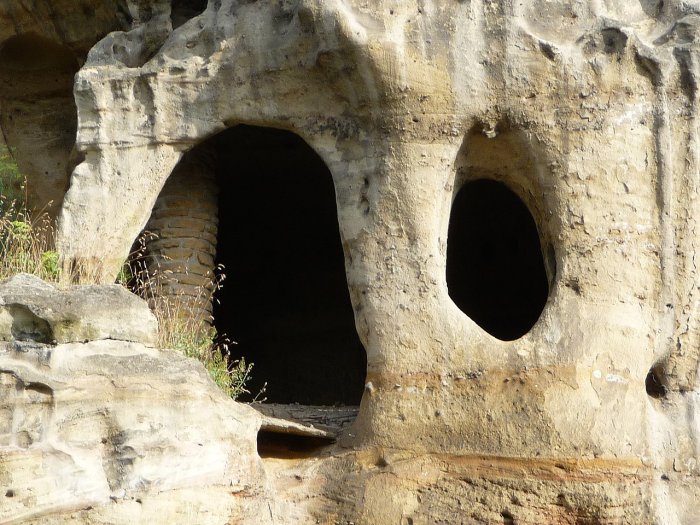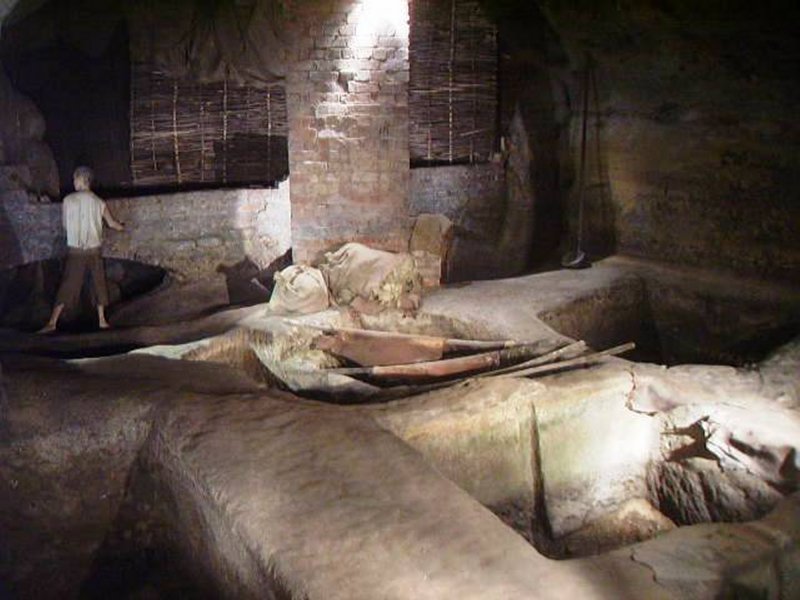Secret Passageways And Caves Beneath UK’s City Of Nottingham
A. Sutherland - AncientPages.com - Many histories of Nottingham have been produced. People made their own observations and studied the city's past. Yet others published information from other sources, which unfortunately were never identified or simply no longer survived and therefore cannot be verified. There are about 870 caves identified so far.
Rock cut houses south of Nottingham Castle. Image credit: Immanuel Giel - CC BY-SA 4.0
Many stories have been passed down from one generation to another. However, this information is not necessarily accurate. We know that beneath Nottingham Castle is a labyrinth of manmade tunnels and caves hollowed out of the sandstone cliffs.
The walls of these underground realms have a long history and keep many secrets of Nottingham and another very ancient city located beneath the streets of the old town.
The first settlers lived in caves, which later became cave systems. About five hundred caves were used as work areas, cellars, and probably very often as homes. Many poor people lived in these caves, usually occupying only single-room basements. Such habitats were overpopulated, and diseases and lack of proper hygiene were serious problems.
Nottingham was once known as Tigguo Cobauc, meaning "place of caves" or "a place of cave dwellings." It was referred to as such by The Bishop of Sherborne Asser in "The Life of King Alfred" (893AD). The City of Caves, where Nottingham sits, was carved into very soft sandstone rock with simple tools.
Digging of subterranean cave dwellings, underground bowling alleys, painstakingly chiseled tunnels, and jail cells began long ago and served many purposes.
Nottingham Caves. Location: Drury Hill, Nottingham. Image credit: Enchufla Con Clave - CC BY-SA 4.0)
Nottingham Castle's underground caves and tunnels have hundreds of years of dramatic history hidden within their walls. More than 300 steep stairs go down to these creepy and cold spaces that can only be accessed on guided tours.
Some caves served as wine cellars due to their constant temperature of 14 degrees Celsius, and several caves date back to medieval times. Sometimes, they served as a chapel, kilns for malt and pottery, or tanneries. Frequently, they were also used as a secret entrance into Nottingham Castle.
Other caves were used as cells to house prisoners. There is also convincing evidence for gaol cell caves used in medieval and post-medieval times to house prisoners. There have also been tales of druids living in caves once.
The tunnels are strongly related to the famous legends of Robin Hood, who was said to use them to escape the Sherriff of Nottingham. One cave is said to have been used as 'oubliette' ('forgotten place') in which Robin Hood, a legendary heroic outlaw originally depicted in English folklore, may have been kept prisoner before being rescued by Little John.
Credit: Adobe Stock - Jonathan
Another mysterious place is King David's legendary dungeon, a dark, gloomy place with walls decorated with pictures, which are believed to have been made by King David of Scotland after the battle of Neville's Cross in 1346. He and his captors stayed here for 12 days while he recovered from an arrow wound to the face. He spent this time sitting in this cold and dark cave.
Yet another famous place is Mortimer's Hole, an eerie tunnel carved into the sandstone outcrop on which Nottingham Castle stands. King Edward III used the place to capture his mother, Queen Isabella, and her lover, Roger Mortimer, the Earl of March. Mortimer and Isabella are said to have plotted the death of her husband and his male lover.
Isabella's son, the young King Edward III, accompanied by a group of nobles, entered the Castle via the tunnels, burst into his mother's bedroom, and arrested Mortimer. The doomed Sir Mortimer was imprisoned in the cave now known as Mortimer's Hole before being taken to London and executed as a traitor. He was hung, drawn, and quartered on 29 November 1330. His wretched remains were skewered on spikes and left to rot on the traitors' gate at 'Tyburn.'
The tunnel that led to Sir Roger's downfall became known as" Mortimer's Hole" and is so to this day.
Nottingham caves have no doubt a long history.
Medieval Tannery at City of Caves in Nottingham. Image credit: Mutt - CC BY-SA 3.0
The Anglo-Saxon Chronicle records say that during 868-869 AD - Vikings wintered in Nottingham:
"In this year the (Danish) army went into Mercia to Nottingham and took up winter quarters there. And Burgred, the king of the Mercians, and his councillors asked Ethelred, the king of the West Saxons, and his brother Alfred to help him to fight against the army. They then went with the army of the West Saxons into Mercia to Nottingham, and came upon the enemy in that fortress, and besieged them there. There occurred no serious battle there, and the Mercians made peace with the enemy. In the following year the raiding army returned to York..."
In his fascinating book Nottingham: "The Buried Past of a Historic City Revealed", Lomax, Scott writes that "there were caves in Nottingham from at least the late Saxon period. However, the locations of these earliest caves (if they survive at all) are unknown, with the earliest dated caves believed to date to c. 1250.
Image credit: Immanuel Giel - CC BY-SA 4.0
"By 1609, there must have been hundreds of caves because a document of that year states, 'the whole town is in a manner undermined with caves of an amazing depth and extent, go that it is even questioned whether all the buildings on the surface of the rock would fill up the vacancies underneath.'
Many of the caves have had their appearance, extent, and function altered throughout time. Indeed if any of the caves first hewn in Saxon times still survive, there is every possibility that they have been enlarged or modified to such an extent that their original outline in plan has been destroyed.
Many of the caves were identified and investigated during the Victorian period when development work was being undertaken…" 1
It will be a difficult question to answer if we ask: how many caves once existed but which have been destroyed over the centuries? We have to continue to guess and speculate. According to experts, the old Nottingham has had one thousand caves, and "the earliest caves were located where the earliest known occupation existed…" 1
Updated on November 10, 2023
Written by – A. Sutherland - AncientPages.com Senior Staff Writer
Copyright © AncientPages.com All rights reserved. This material may not be published, broadcast, rewritten or redistributed in whole or part without the express written permission of AncientPages.com
Expand for referencesReferences:
- Lomax, Scott. Nottingham: The Buried Past of a Historic City Revealed
Pearson R., Old and New Nottingham 1881
Marshall G. Visitations of the County of Nottingham 1559 - 1614
More From Ancient Pages
-
 Cyclops – First Generation Of Giants Who Were Prisoners Of Tartarus
Featured Stories | Mar 21, 2018
Cyclops – First Generation Of Giants Who Were Prisoners Of Tartarus
Featured Stories | Mar 21, 2018 -
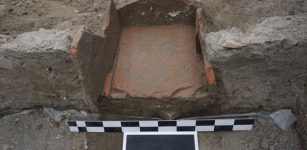 Ancient ‘Refrigerator’ And Unique Coins Discovered In Roman Military Camp In Bulgaria
Archaeology | Oct 3, 2022
Ancient ‘Refrigerator’ And Unique Coins Discovered In Roman Military Camp In Bulgaria
Archaeology | Oct 3, 2022 -
 Medieval Grave And Skeleton With Arrow In Chest Unearthed In Ancient City Of Plovdiv, Bulgaria
Archaeology | Dec 28, 2017
Medieval Grave And Skeleton With Arrow In Chest Unearthed In Ancient City Of Plovdiv, Bulgaria
Archaeology | Dec 28, 2017 -
 2,500-Year-Old Olmec Related Mexican Cave Paintings Are Now Restored And Protected
Civilizations | Sep 18, 2015
2,500-Year-Old Olmec Related Mexican Cave Paintings Are Now Restored And Protected
Civilizations | Sep 18, 2015 -
 Amazing Margate Shell Grotto – Kent’s Greatest Mystery
Featured Stories | Jun 10, 2014
Amazing Margate Shell Grotto – Kent’s Greatest Mystery
Featured Stories | Jun 10, 2014 -
 Berserkers In Mesopotamia, Europe And India: Old Tradition Of Mad Fighting Dates Back At Least 3000 BC
Ancient Traditions And Customs | Jun 6, 2017
Berserkers In Mesopotamia, Europe And India: Old Tradition Of Mad Fighting Dates Back At Least 3000 BC
Ancient Traditions And Customs | Jun 6, 2017 -
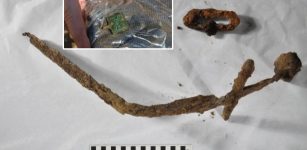 Crusader-Era Sword Discovered At Previously Unknown Burial Site In Finland
Archaeology | Oct 16, 2023
Crusader-Era Sword Discovered At Previously Unknown Burial Site In Finland
Archaeology | Oct 16, 2023 -
 Two Men Sentenced To Prison For Vandalism Of 4,000-Year-Old Petroglyphs In Nevada
Archaeology | Nov 12, 2022
Two Men Sentenced To Prison For Vandalism Of 4,000-Year-Old Petroglyphs In Nevada
Archaeology | Nov 12, 2022 -
 Mystery Of The 290-Million-Year-Old Zapata Footprint In New Mexico
Featured Stories | Sep 23, 2020
Mystery Of The 290-Million-Year-Old Zapata Footprint In New Mexico
Featured Stories | Sep 23, 2020 -
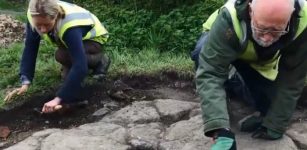 Uncovering 16th Century Scottish Royal Dockyards Used By King James IV’s Navy
Archaeology | May 24, 2018
Uncovering 16th Century Scottish Royal Dockyards Used By King James IV’s Navy
Archaeology | May 24, 2018 -
 Thousands Of Roman Coins Found Across Europe Are Fake – Archaeologists Say
Archaeology | Jul 9, 2019
Thousands Of Roman Coins Found Across Europe Are Fake – Archaeologists Say
Archaeology | Jul 9, 2019 -
 The Great Flood And Noah’s Ark Were Real Events – Scientist Says
Featured Stories | Jun 21, 2014
The Great Flood And Noah’s Ark Were Real Events – Scientist Says
Featured Stories | Jun 21, 2014 -
 Ancient DNA Illuminates Unknown ‘Ghost’ Populations In Sub-Saharan Africa
Archaeology | Jan 22, 2020
Ancient DNA Illuminates Unknown ‘Ghost’ Populations In Sub-Saharan Africa
Archaeology | Jan 22, 2020 -
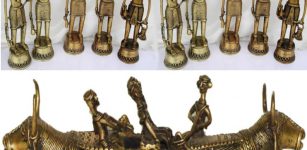 Telangana And Great Ancient Iron Masterwork Of Skilled Blacksmiths Of India
Ancient Technology | May 26, 2017
Telangana And Great Ancient Iron Masterwork Of Skilled Blacksmiths Of India
Ancient Technology | May 26, 2017 -
 Madagascar Hippos Were Forest Dwellers – New Study
Fossils | Jul 8, 2023
Madagascar Hippos Were Forest Dwellers – New Study
Fossils | Jul 8, 2023 -
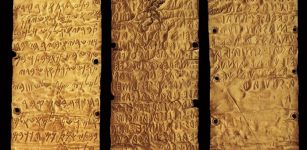 Pyrgi Gold Tablets: A Rare Ancient Bilingual Treasure
Artifacts | Nov 23, 2018
Pyrgi Gold Tablets: A Rare Ancient Bilingual Treasure
Artifacts | Nov 23, 2018 -
 Ancient Liangzhu Culture Collapsed Due To Climate Change – New Study Says
Archaeology | Nov 25, 2021
Ancient Liangzhu Culture Collapsed Due To Climate Change – New Study Says
Archaeology | Nov 25, 2021 -
 Remarkable Ancient Windcatchers: Air Conditioning Systems Built Since Antiquity
Ancient Technology | Sep 3, 2016
Remarkable Ancient Windcatchers: Air Conditioning Systems Built Since Antiquity
Ancient Technology | Sep 3, 2016 -
 Problems With The Age Of Man And Theory Of Evolution – What Happened In The Past?
Ancient Mysteries | Oct 11, 2021
Problems With The Age Of Man And Theory Of Evolution – What Happened In The Past?
Ancient Mysteries | Oct 11, 2021 -
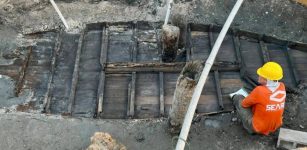 Remarkable Discovery Of A 19th-Century Boat Buried Under A Road In St. Augustine, Florida
Archaeology | Oct 16, 2023
Remarkable Discovery Of A 19th-Century Boat Buried Under A Road In St. Augustine, Florida
Archaeology | Oct 16, 2023

